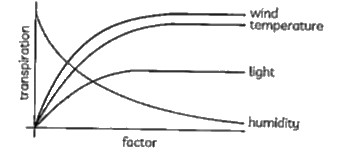I. Highest density of organism.
II. Epiphyte care abundant.
III. Temperature is high and uniformed.
IV. Climate is humid and warm.
The above statement describes which of the following ecosystem?
Tropical savana
Tropical Deciduous forest
Tropical rain forest
All of the above
The correct Answer is:C
To determine which ecosystem is described by the four statements provided, we can analyze each statement step by step:
Step 1: Analyze the Statements
1. Highest density of organism: This indicates that the ecosystem has a rich biodiversity, meaning a large number of different species and individuals are present.
2. Epiphyte care abundant: Epiphytes are plants that grow on other plants, typically found in environments where there is plenty of moisture and support from larger plants. This suggests a lush environment.
3. Temperature is high and uniform: A high and consistent temperature throughout the year suggests a tropical climate, where seasonal changes are minimal.
4. Climate is humid and warm: A humid and warm climate is conducive to a variety of life forms, particularly those that thrive in moist conditions.
Step 2: Identify Possible Ecosystems
Now, let's evaluate the ecosystems mentioned in the video transcript based on these characteristics:
1. Tropical Savanna: This ecosystem is characterized by grasslands with scattered trees. It does not typically have a high density of organisms or abundant epiphytes, as it is more open and dry compared to other ecosystems.
2. Tropical Deciduous Forest: While this ecosystem experiences significant rainfall, it does not maintain a consistently high temperature throughout the year. The biodiversity is moderate, and it does not support a high density of epiphytes.
3. Tropical Rainforest: This ecosystem is known for having the highest density of organisms, including a vast variety of species. It supports abundant epiphytes due to its humid conditions. The temperature is consistently high and uniform, and the climate is warm and humid, making it ideal for diverse life forms.
Step 3: Conclusion
Based on the analysis of the statements and the characteristics of the ecosystems, the correct answer is:
Tropical Rainforest.
1. Highest density of organism: This indicates that the ecosystem has a rich biodiversity, meaning a large number of different species and individuals are present.
2. Epiphyte care abundant: Epiphytes are plants that grow on other plants, typically found in environments where there is plenty of moisture and support from larger plants. This suggests a lush environment.
Now, let's evaluate the ecosystems mentioned in the video transcript based on these characteristics:
Based on the analysis of the statements and the characteristics of the ecosystems, the correct answer is:
Similar Questions
Consider the following statements,
I. Graphite and silica are the examples of elements.
II. The most abundant element in human body is oxygen.
III. Mercury is the metal at room temperature.
Which of the above statement(s) is/are correct?
View SolutionSelect the correct statements.
(I) Greater is humidity, lesser will be rate of evaporation of water.
(II) Greater is humidity, lesser will be density of air.
(III) If room temperature = dew point, realtive humidity =100%.
(IV) Dew point is the temperature at which the gas a given atmospheric condition becomes staturted with H2O (v)
View Solution
Knowledge Check
If the wind is strong, kites are flown.
If the sky is not clear, kites are not flown.
If the temperature is high, kites are flown. assume the statement above to be true ,if kites are flown . which of the following statement definitely true
I. The wind is strong.
II. The sky is clear.
III. The temperature is not high.AI onlyBII onlyCIII onlyDI and III onlyConsider the following characteristics of a tropical cyclone:
1.A warm sea temperature of gt 26∘ C
2 High Relative humidity of atmosphere at a height of gt 700m
3 Atmospheric instability
The above mentioned characteristics are associated with which one of the following cycles of its development?AFormulation and initial stageBModification stageCFull maturityDDecayConsider the following statements
I, Elements vary in abundance.
II. Cu is the most abundant element in earth’s crust.
III. Al is the major component of mica and clays,
Which of the above statement is/are correct? Choose the correct option.AI and IIBII and IIICI and IIIDAll of these
A plot of various abiotic factors affecting the rate of transpiration is given below :

After analyzing the graph a student writes the following statements
(I) The rate of transpiration increases with increase in light intensity, wind speed and humidity
(II) The rate of transpiration decreases linearly with increases in light intensity , temperature and humidity
(III) The rate of transpiration decreases with increase in humidity
(IV) The rate of transpiration increases with increase in light intensity, temperature and humidity
Choose from the following which of the following would be the correct statements (s)
View SolutionConsider the following statements
I. Sulphur occurs free in nature.
II. Living organism contain iron in haemoglobin.
III. Gold is found in the sediments in the ocean floor.
Which of the above statements are true? Choose the correct option.
View SolutionConsider the following statements :
The mean free path of gas molecules
I. decreases with increase in concentration
II. increases with decrease in pressure at constant temperature
III. decreases with increase in molecular size
Which of the above statements are correct?
View SolutionConsider the following statements regarding the climate of Sahara desert?
I. The climate of the Sahara desert is scorching hot and dry.
II. The sky is cloudless and clear.
III. It receives plenty of rainfall.
IV. The nights may be freezing cold with temperatures nearing zero degrees.
Of the above statements, which are correct.
View SolutionRead the following statements carefully : (i) product of a volt and an ampere is a joude/second (ii) The product of a volt and watt is horse power (iii) The product of a volt and a coulomns is joule (iv) Walt-hour can be measured in terms of electron-volt
View Solution

